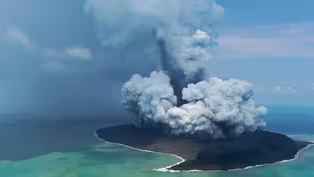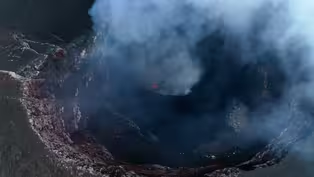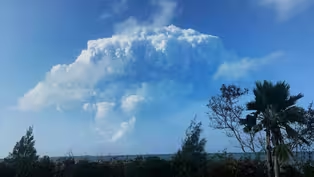
How an Underwater Volcano Produced a 60-Foot Tsunami
Clip: Season 50 Episode 8 | 2m 35sVideo has Closed Captions
The most explosive event ever recorded on Earth—and the massive tsunami that followed.
On January 15, 2022, an underwater volcano erupted off the shores of the Pacific islands of Tonga—the most explosive event ever recorded on Earth. The blast triggered a massive tsunami with waves over 60 feet high. Here's how it happened.
Problems playing video? | Closed Captioning Feedback
Problems playing video? | Closed Captioning Feedback
Major funding for NOVA is provided by the NOVA Science Trust, the Corporation for Public Broadcasting , and PBS viewers.

How an Underwater Volcano Produced a 60-Foot Tsunami
Clip: Season 50 Episode 8 | 2m 35sVideo has Closed Captions
On January 15, 2022, an underwater volcano erupted off the shores of the Pacific islands of Tonga—the most explosive event ever recorded on Earth. The blast triggered a massive tsunami with waves over 60 feet high. Here's how it happened.
Problems playing video? | Closed Captioning Feedback
How to Watch NOVA
NOVA is available to stream on pbs.org and the free PBS App, available on iPhone, Apple TV, Android TV, Android smartphones, Amazon Fire TV, Amazon Fire Tablet, Roku, Samsung Smart TV, and Vizio.
Buy Now

NOVA Labs
NOVA Labs is a free digital platform that engages teens and lifelong learners in games and interactives that foster authentic scientific exploration. Participants take part in real-world investigations by visualizing, analyzing, and playing with the same data that scientists use.Providing Support for PBS.org
Learn Moreabout PBS online sponsorship- [Shane] It felt like I'm witnessing Mother Earth's might and power being released.
- [Narrator] Eight hours later, the volcano stopped erupting.
Then at 5:15 PM on January 15th, (dramatic music) it produced an eruption over 70 times larger, exploding with the power of over 60 million tons of TNT and triggering a series of tsunami waves that hit Tonga, Australia, Japan and the Americas.
This is the site of the volcano.
All that is visible are two small islands, Hunga Tonga and Hunga Ha'apai.
- Looking behind me, you'll see the island of Hunga Ha'apai, so that's right on the edge of the volcano.
The main volcano's actually over to the east.
So in this great big expanse of what looks just like completely clear ocean, we're actually sitting right on top of the Hunga caldera.
So below us is actually the volcano - [Narrator] Hunga Tonga-Hunga Ha'apai is a submarine volcano.
It's two and a half mile wide crater, sits at the top of a mountain, nearly 6,000 feet tall, which is almost completely hidden underwater.
Only in two places is the crater wall high enough to break the surface, forming the two islands.
Before the January 15th eruption, the volcano looked very different.
The center of the crater was 2,300 feet shallower.
- During the first one and a half hours, it was ejecting material at a rate twice as much as the next biggest eruption that we know of.
It threw out seven cubic kilometers of dense rock material.
- [Narrator] That's enough to cover the entire island of Manhattan in nearly 400 feet of debris.
- When a large amount of magma erupts from a volcano, large amounts of magma come out at once, and so that means that the top part of the volcano actually then sinks in on itself.
- [Narrator] Shane's idea is that as material erupted out of the magma chamber, it created a larger and larger void underground.
When it could no longer support the weight of material above, the entire caldera dropped over 2,300 feet.
Seawater flooded in, kickstarting tsunamis that radiated out from the volcano, an explanation of how the volcano could generate a 60-foot wave.
(gentle piano music)
Video has Closed Captions
Preview: S50 Ep8 | 30s | Investigate one of the most powerful volcanic eruptions in recorded history. (30s)
Scientists Make Rare Discovery in Active Volcano
Video has Closed Captions
Clip: S50 Ep8 | 2m 58s | Volcanologists visit Tofua to study the volcano’s activity. (2m 58s)
Witnesses Recount Surviving a Volcanic Explosion
Video has Closed Captions
Clip: S50 Ep8 | 2m 57s | Hear witnesses share how they survived the most explosive event ever recorded on Earth. (2m 57s)
Providing Support for PBS.org
Learn Moreabout PBS online sponsorship
- Science and Nature

Capturing the splendor of the natural world, from the African plains to the Antarctic ice.













Support for PBS provided by:
Major funding for NOVA is provided by the NOVA Science Trust, the Corporation for Public Broadcasting , and PBS viewers.





